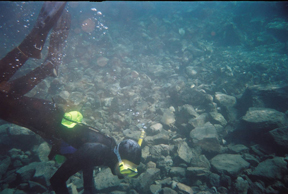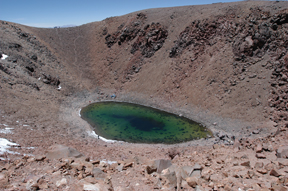


 |
 |
Planetary geologist Nathalie Cabrol of the NASA Ames Research Center/SETI Institute has been searching high and low on Earth for clues to the possible existence of life on Mars.
Nathalie Cabrol free dives in Lake Helen in northern California. The dive, at more than 2 kilometers elevation, was training for a 2003 dive in the Licancabur summit lake (lower image) — one of the highest lakes in the world, standing at 6 kilometers high — nested about 90 meters below the rim of a volcanic crater on the border between Chile and Bolivia. Cabrol, a planetary geologist, hopes to learn more about extreme life in the universe by investigating microbial communities in such high lakes. Image is courtesy of Brian Grigsby, NASA ARC/SETI Institute.
In 2001, while leading a science team that employed a robotic rover to search for life in the driest place on Earth, Chile’s Atacama Desert, she sought other locations that might resemble the martian environment. A colleague mentioned a lake on the summit of the dormant Licancabur volcano on the border between Chile and Bolivia, one of the highest volcanic lakes in the world at 6,000 meters. By July of 2002, armed with a two-year reconnaissance grant and a crew of three, Cabrol visited Licancabur for the first time. Shortly after reaching the base of the mountain, she sat in a 100-square-kilometer field of stromatolites — the fossil remains of ancient cyanobacteria — and marveled at the adventure she had gotten herself into.
The next few years would find the French/American planetary geologist free-diving — without oxygen tanks — in the 4 degree Celsius Licancabur summit lake, enduring minus 40 degree Celsius temperatures and 100 kilometer-per-hour winds, and forming new hypotheses about the survival of life in extreme environments.
“These high lakes have exactly the same physical environment as Mars 3.7 billion years ago when conditions changed,” Cabrol says. “The atmospheric pressure is the same, the environment is the same, the temperature is the same — you name it, this is probably the best analog in the world to ancient martian lakes.”
Having Earth analogs to martian sites is important to scientists trying to understand the conditions under which life may have existed — and may still exist — on the red planet. The small Licancabur summit lake, measuring only 90 meters by 70 meters by 4.5 meters deep, has been evaporating slowly over thousands of years, so it is an excellent place to examine how life adapted as water disappeared.
From 2002 to 2003, Cabrol and her team set up UV and meteorological equipment, analyzed water chemistry, and took biological samples at the summit lake and at two small lakes near the base of Licancabur called Laguna Verde and Laguna Blanca. All three lakes were teeming with life.
They discovered at least one species of diatom that was thought to be extinct, and noted that others had 10 times the mutation rate of diatoms in more UV-protected locations. Most fascinating was the discovery of more life in Laguna Blanca, which is only 50 centimeters deep, than in the 5-meter-deep Laguna Verde. Scientists have long accepted that UV rays penetrate 50 centimeters into a water column, killing all microbial life. If this were true, then Laguna Blanca should be a microbial graveyard, but it clearly was not.
Cabrol’s quest to understand how life is thriving in these high lakes earned her a five-year grant from the NASA Astrobiology Initiative in 2003. The real fun started that year with the first free dive in the Licancabur summit lake — her favorite part of the mission. The weather was perfect: Half of the lake had thawed, and she and her colleagues were able to dive in two teams of three to take bathymetric measurements.
Accompanying Cabrol was Scott Parazynsky, a space shuttle astronaut who handled the still camera, and Greg Kovacs from Stanford University, who held the video camera. After the first team photographed and marked interesting spots, a second team collected water and sediment samples for laboratory analysis.
Perhaps the greatest adventure came last year, when minus 40 degree Celsius temperatures and 100 kilometer-per-hour winds forced the team to alter its plans. The summit lake was frozen and over-nighting there was too dangerous, so they decided on a rapid one-day assault. “We climbed that mountain at 200 to 300 vertical meters per hour,” Cabrol says, noting that it rises at a 42 degree angle. “We left mid-camp at 7:30 in the morning and we were at the summit by 11:15. We couldn’t believe it!”
After taking ice cores from the lake’s surface, to test the airborne contribution to sedimentation, and sampling some frozen soil, which proved to contain eggs and various algae, the team returned safely to base camp that night. They then began a 700-kilometer-long trek across the highlands to Poquentica, a 5,850-meter-high volcano in Bolivia, which also has a summit lake. The team climbed Poquentica just 10 days after the rapid ascent of Licancabur. Future plans call for exploring at least three other summit lakes in the region.
From these experiences, Cabrol has developed a new perspective on how scientists might think about extreme conditions. “Usually we study extremes individually, and look at their impacts on life,” she says. “Because we have a natural laboratory at Licancabur, we can look at these extremes as a system — how do they interact with each other?”
She cites three possible types of interactions: The extreme conditions can combine to worsen each other, making it harder for life to survive; they can cancel each other out, neither enhancing nor detracting from life’s chances; or they can combine in a milder, subtractive way to delay the onset of the worst effects. This last scenario may delay the complete destruction of a habitat, thus buying more time for life, she says. Perhaps this third type of interaction accounts for the teeming microbial life in Laguna Blanca, as some extreme condition is delaying the deadly effects of UV radiation.
“You know what life does with time,” Cabrol says. “It adapts to more and more difficult extremes.” When she thinks about Mars, she wonders if the lag time is long enough for life to have transitioned from evaporating lakes to subsurface environments with very small amounts of moisture.
For now, Cabrol thinks the answer may be yes: “This project is making me a great optimist about the potential for life.”
Palucka is a contributing writer for Geotimes.
 |
Geotimes Home | AGI Home | Information Services | Geoscience Education | Public Policy | Programs | Publications | Careers |